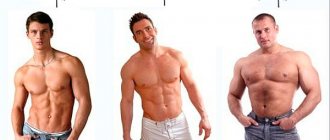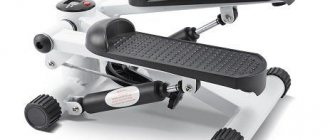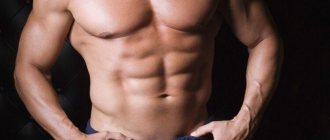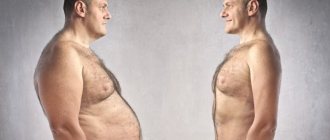What influences body type?
One of the criteria for assessing development and health is the proportionality of the body. If the proportionality is disturbed, then we can assume chromosomal, endocrine disorders that have an impact on the growth process.
The constitution of the human body is a set of characteristics of the body, formed from hereditary and acquired properties, many of which become obvious at an early stage of child development. Some children have a fragile physique, others have an excess of fat tissue over muscle tissue, and still others are endowed with strong muscles.
As you grow older, body features become fixed and by the age of 11 you can determine the type of constitution of the child.
Over the years, scientists have determined body types based on body proportions, but their classification is not an exact science.
- Normosthenic. This type includes people whose body sizes correspond to age parameters.
- Asthenic. People with this body type have elongated limbs, narrow bones, a thin layer of fat, and poorly developed muscles.
- Hypersthenic. In this case, people have well-developed muscles, average height, and transverse dimensions predominate in the existing body proportions.
Classification of species is not an exact science, and there are often many variations within a single “type.” The medical term “physique” includes the constitution, height, and weight of a person.
Practical meaning of the human constitution:
- Medicine. Knowledge of proportions helps diagnose diseases and is used in medical anthropology.
- Physical education. Helps you decide on the choice of sports activities.
- Industrial production. Body parameters are taken into account in the production of clothing and shoes.
Ectomorph, mesomorph, endomorph. How to determine who you are?
In particular, an arbitrary seven-point scale is retained; the distribution intervals of the fat component scale are given in accordance with the Sheldon average values. Graphically, a somatoslice is expressed as a point on a plane with three coordinate axes located at an angle of 120° to each other.
Somatoslice Heath-Carter. Explanation in the text
The axes are endomorphy (“fat”—left-down), mesomorphy (“muscles”—up), and ectomorphy (“bones”—right-down). For example, more fit, slender people are “located” on the somatoslice plane in the region of zero, somewhat to the right of the origin of coordinates, fashion models - even more to the right; bodybuilders are located along the mesomorphy axis in the upper part of the plane with a Y value of more than ten, and excess weight pushes the point to the left of zero.
As muscle mass and the amount of fat in the body changes, the somatoslice will change, and in comparison with the points of previous measurements, you will be able to observe the drift of the current point, showing the direction of changes occurring in your body. The advantage of the Heath-Carter scheme is that it is recommended by the authors for people of both sexes, all nationalities and races, ranging in age from 2 to 70 years.
Modern somatotyping techniques
Today, there are numerous modifications of somatotyping, for example by V.P. or M.V. Chernorutsky, which is traditionally used in medical practice to designate constitutional types.
With this scheme, the following three types are distinguished:
- Normosthenic type, characterized by proportional body size and harmonious development of the musculoskeletal system;
- The asthenic type, which is distinguished by a slender body, weak development of the muscular system, a predominance (compared to the normosthenic) of the longitudinal dimensions of the body and the size of the chest over the size of the abdomen; the length of the limbs is above the length of the body;
- The hypersthenic type, which differs from the normosthenic type by good fatness, a long body and short limbs, a relative predominance of the transverse dimensions of the body, the size of the abdomen over the size of the chest.
There are three main body types (or somatotypes):
- Mesomorphic;
- brachymorphic or its opposite dolichomorphic.
The mesomorphic body type includes people whose anatomical proportions are close to the average normal parameters (they are also called normosthenics).
The brachymorphic type includes people who are usually short in stature and whose anteroposterior dimensions predominate (hypersthenics).
They are distinguished by a round head, large belly, and relatively weak arms and legs. People belonging to the third, dolichomorphic type, are distinguished by their slenderness, lightness, relatively longer limbs, poorly developed muscles and thin bones. The subcutaneous fat layer is almost absent.
It can be argued that, regardless of the somatyping technique, the resulting somatotypes differ slightly from each other in terms of body length and weight, bone and muscle components.
The relationship between body features and the reactivity of the body, metabolism, dynamics of ontogenesis, endocrine immune indicators, and characteristics of temperament proves that the somatotype can act as the basis for constitutional diagnosis and assessment of physical development.
Here anthropology is intertwined with the idea of homeostasis, as a fundamental property of life to maintain a stable existence in changing environmental conditions. The study of homeostatic mechanisms is carried out at different levels of organization of biosystems (from a cell to a whole organism, under normal conditions and during adaptation to changes in the external environment).
Indices and types of bodily proportions
The constitution of the human body is a set of sizes of some parts of the human body and their ratio. One of the common ways to determine proportions is the index method, when the smaller size is determined as a percentage. This method calculates the relative width of the shoulders to the total length of the body and the length of the lower limbs.
Based on calculations, 3 types of human physique were identified:
- Brachymorphic. This species is characterized by powerful, highly developed shoulder muscles, a shortened but wide chest, and a large slope of the pelvic angle. The body of a typical representative may be long, but the height is low due to short legs.
- Dolichomorphic. A representative of this type has elongated limbs and a narrow body. High growth is ensured by long limbs, and these people also have a small pelvic angle.
- Mesomorphic. Determined by the average values of previous species.
The calculation methodology for physical development using indices includes:
- Thoracic height index , I=T– 0.5 L (I – index, T – chest circumference after a sigh, L – body length in cm). For men +5.8, for sports women +3.8 cm.
- Weight-height index , I=P/L (P – weight, L – length). For men = 360-400 g/cm, and for women 320-370 g/cm.
- Vital index , I=VC/P (I – index, vital capacity of the lungs, P – body weight in kg). The male index is 60-62 ml/kg, the female 50-52 ml/kg.
Endomorphic type
The endomorphic type of male body, also known as stocky, is distinguished by a powerful and relatively heavy skeletal system, a wide and short chest, a soft muscular system, a thick and short neck, and a decent amount of fat. Such people often have a tendency towards obesity.
The purpose of physical exercise for a man with an endomorphic physique is to combat obesity. It is necessary to build muscle mass, which is often deeply hidden under a thick layer of fat.
The most effective workouts are cyclic, aimed at restructuring the body towards building muscle mass and burning fat. Over time, the body will become more prominent.
One of the common mistakes of endomorphic men is the idea that long and frequent running should help burn fat. For an endomorphic physique, this approach is not entirely effective, since only internal fat will be burned. Workouts should include regular warm-ups, running and strength training in the gym.
The frequency of classes is 3-4 times a week. It is recommended to include outdoor activities and walks in your schedule (morning or evening jogging, cycling, sports games, swimming, etc.).
Particular attention should be paid to nutrition. Many people make the mistake of completely giving up food and resorting to “starvation” diets. Fasting can eat away both fat and muscle, and the lost weight is then quickly restored, bringing with it new layers of fat.
You need to monitor your carbohydrate intake: no more than 100 grams per day. They are recommended to be consumed 40-45 minutes before an intense workout and 30-40 minutes after it ends. You need to eat more food containing calcium, magnesium, amino acids (BCAA). It is also important not to consume excessive amounts of fat.
Kretschmer's typology of human physique
The German psychiatrist and psychologist E. Kretschmer, in his famous work “Physique and Character,” put forward the theory that certain mental disorders are common among people of certain physical types.
According to the scientist, only genetic factors influence the human constitution. Social reasons do not affect the development of the somatotype. The scheme developed by E. Kretschmer was offered only for men.
He divided personalities into 4 types:
| Somatotypes | Traits inherent to this type |
| Sports or athletic | These people have good skeletal and muscular development and a slender body. Height is average or above average. These people have the personality traits of introverts and are more susceptible to serious mental disorders, schizophrenia. |
| Picnic | People of this type are characterized by large abdominal cavity sizes and numerous fat deposits. Their figure is compact and their height is short. They have the personality traits of extroverts. Such people are more susceptible to mental disorder, manic-depressive psychosis. |
| Asthenic | Tall men with narrow shoulders and underdeveloped muscles fit this type. They are energetic and aggressive, comparable to ambiverts and prone to mental disorders. |
| Leptosomatic | Leptosomatic (from Greek leptos - “fragile”, soma - “body”) - asthenic. The shape of the body is cylindrical, the physique is fragile, the height is tall. The shoulders are narrow, the legs are long and thin. The face is elongated, egg-shaped. |
The psychiatrist suggested that lanky asthenic types, and to a lesser extent athletic types, are more prone to schizophrenia, while picnic types are more prone to developing manic-depressive disorders. His work was criticized, but Kretschmer's ideas to some extent entered popular science and spawned further psychological research.
Asthenic physique
Women of this constitution are characterized by general thinness, a long and thin neck, narrow shoulders, a flat and narrow chest, elongated thin limbs, an elongated face and a thin nose. Height is often above average. The muscles of such women are poorly developed. Therefore, they lack strength and endurance. But the representatives of this group are energetic, light and graceful, and have little weight. One of the obvious advantages of an asthenic physique is the minimal tendency to be overweight.
Asthenics often have tall stature and a fragile skeletal system. Due to their structural features, they have low blood pressure and a reduced level of hemoglobin. They often suffer from problems with the spine. Among the “occupational” diseases are frequent colds, stomach problems and vegetative-vascular dystonia. Such people are very thermophilic and do not tolerate cold well.
When choosing sports disciplines, it is better to give preference to those that are aimed at developing missing skills: strength and endurance. These include swimming, aerobics, and dancing. To correctly classify your body type as thin-boned, measure the circumference of your wrist. In the group under consideration, it should be less than 16 cm.
- » Figure grace calculator
- » Fitness calculator
- » Weight gain
What types of physiques are there in men, their distinctive features
The term somatotype is used in the classification system of human physical types developed by the American psychologist W. Sheldon. According to his classification system, a person can be correlated with one of the body types: endomorphic or round type, mesomorphic or muscular type, and ectomorphic or thin, linear type.
Sheldon proposed a theory of personality that correlated temperament and body type. He divided people into three categories called "soma types", which were named after the germinal layers of the body of multicellular animals.
- Endomorph. Corresponds to the inner layer, the endoderm, from which the digestive system was formed.
- Ectomorph. The name is compared with the outer ectoderm from which the formation of the skin, glands, and nervous system occurred.
- Mesomorph. The name of the type is derived from the mesoderm, from which the cardiovascular and musculoskeletal systems were formed.
Most people do not have a pure match in somatotype characteristics. A person always has average characteristics that take into account gender, age, and developmental characteristics.
The constitution of the human body is not only external morphological characteristics, but also physiological indices. It is difficult to find pure representatives of all body types, since the indicators of certain parts of the body can be classified with different options.
Ectomorphs
Individuals belonging to this group have the following characteristics:
- thin face with a high forehead and drooping chin;
- narrow chest and toned abdomen, with no subcutaneous fat;
- thin, rather long arms and legs;
- narrow body.
Ectomorphs demonstrate greater social anxiety and introversion, and have the makings of analytical thinking. They have a fast metabolism, which requires more calories and more training. These people are hardy, very flexible and dexterous. A person belonging to this group gains weight easily. If he becomes fat, he is still considered an ectomorph, just overweight.
Endomorphs
An individual of this group is characterized by a round shape, his body is almost spherical, and he also has:
- large round belly;
- large internal organs corresponding to its size;
- rather short limbs;
- full shoulders and hips;
- thin ankles and wrists.
Gains weight easily, has a higher percentage of body fat, and is prone to obesity. Under normal conditions, such a person has a lot of fat, but if he starves, he remains endomorphic, only becomes thinner.
Mesomorphs
This physical type is characterized by good muscle development.
Mesomorphs in their pure form have:
- big head;
- massive muscular chest, shoulders;
- minimum body fat;
- pronounced muscles on the lower and upper limbs;
- excellent posture;
- narrow hips and broad shoulders.
This somatotype easily gains muscle mass, it has strength, speed, and endurance. An example of a mesomorphic person in sports would be a weightlifter, shot putter, or sprinter.
Types and signs of female physiques
The constitution of the female physique was systematized by Professor M.V. Chernorutsky in his works. He identified 3 main types of female body. But the constitutional characteristics of most women cannot be reduced to these three types. This division gives only a general idea of the range of fluctuations in the structure of the human body.
Asthenic appearance
Women in this category have a proportionate figure, long legs, a thin waist, and are of average or slightly above average height. People of this type lack endurance and strength because their muscles are not sufficiently developed. But they are graceful, energetic, and do not tend to be overweight, since the percentage of fat deposits in the body is minimized.
Normosthenic appearance
Normosthenic women have proportional body sizes. This is a balanced and harmonious type of build.
Nature has endowed individuals with such a constitution with fast, sharp movements and well-developed muscle mass. They are slightly taller or average in height, and they rarely develop chronic diseases.
Hypersthenic appearance
Physiological factors that determine women of this type: slightly shortened limbs, the presence of a wide chest, dense bones, height is often below average. A low metabolic rate contributes to rapid weight gain.
Hypersthenic women are hardy and have considerable strength, but lack grace and flexibility.
Asthenic type
Men with an asthenic body type are distinguished by thin limbs, a long and narrow chest, they have fragile and light bones, thin and long muscles, narrow shoulders, and a rather scanty layer of fat.
For men of this body type, physical training rarely gives quick and positive results. As a rule, this is long and hard work.
It is recommended to begin building your own asthenic body with the help of stretching exercises aimed at strengthening ligaments, gradually moving on to loads that increase muscle mass. Strength training and proper nutrition help you achieve success.
You will have to forget about long and exhausting workouts: they should be as hard as possible, but short, so that the calories necessary for building muscles are not burned in vain (in thin men they are very difficult to accumulate, but are easily spent). The estimated frequency of exercise, even strength training, is no more than 45 minutes 2-3 times every week.
The majority of your workouts should consist of compound exercises, including the bench press, squats, deadlifts, and standing presses. They are the ones who are able to involve the main types of muscles in work and contribute to the production of testosterone.
When eating, a man of asthenic type does not need to count calories, but it is recommended to eat as much as possible.
Brown rice can be your favorite side dish. Don't overindulge in sweets. It is recommended to take about 2-3 grams of protein per 1 kilogram of weight per day.
Types of body constitution according to Ayurveda
Indian traditional medicine, Ayurveda, offers its own idea of the human constitution. According to the teaching, there are three types of body energy, corresponding to the elements of fire, air and earth. They are all present in the human body, but the human constitution is determined by one or two, the dominant ones. They may change over the years, but maintaining the balance of the three elements depends on the person himself.
cotton wool
This type of energy belongs to the element of air. Representatives of Vata are creative, extraordinary individuals. They are fueled by the energy of the air, impulsive, sensitive, and are often visited by feelings of anxiety and restlessness.
They have a refined appearance, a slender, flexible body, and tall stature. According to teaching, such people should maintain energy balance with the help of yoga, Pilates, and race walking.
Pitta
People belonging to the element of fire are decisive, quick-tempered, and have all the signs of a leader. They are ambitious, hardworking to the point of exhaustion, filled with emotion and passion. Often individuals with pitta energy are prone to aggression.
According to Ayurveda, these are fair-skinned people, of average height, with red hair, pointed features. The muscular system is well developed, their height is average. The reason for their frequent aggression is an imbalance in their internal balance, so they are recommended to engage in meditation and water sports.
Kapha
People with predominant kapha energy or the earth element are balanced and calm. They strive to achieve harmony, so they are often characterized by laziness and lack of initiative.
They have a strong build, a round figure, and tend to be overweight. They have a large supply of energy, so they are recommended to do jogging, strength training, and aerobics.
Modern methods of somatotyping
Modern science includes at least 60 somatotyping schemes. For classification, estimates of both the component composition of the body are used: bone, fat, muscle, and overall size.
Typical features of a normosthenic body type
Individuals of this type are characterized by proportional body sizes.
The main parameters of a normosthenic:
- classic body type;
- the muscles are clearly expressed and prominent;
- predisposition to obesity is average;
- good endurance, stable body strength.
The complexion of men and women of this type often looks larger than that of asthenics, but this is due not to fat, but to well-developed muscle tissue. Normosthenics have good health and enhanced metabolism.
Typical features of a hypersthenic body type
Hypersthenics have a slow metabolism, which leads them to rapid weight gain.
The main features of hypersthenic:
- stocky appearance, below average height;
- soft rounded facial features and figures;
- ability to quickly gain weight;
- excess amount of subcutaneous fat.
Type Mesomorph
This is the best body type for fitness and bodybuilding and is a cross between an ectomorph and an endomorph. People who have it can both gain and lose weight; without any problems, the distinguishing feature is broad shoulders with a fairly narrow waist.
The main features of a mesomorph are as follows:
1) Naturally athletic, muscular body 2) Quite fast muscle building 3) Gaining excess fat faster than an ectomorph 4) The figure from waist to shoulders is triangular in shape
Calories are better consumed by muscles, average metabolism, but this does not mean that you can relax and rest on your laurels, if you consume few calories, the result will be 0, if there are a lot of calories, and you train half-heartedly and irregularly, excess weight will not make you wait for yourself.
You can find important tips for gaining weight here, and for losing weight here.
There are sometimes mixed types of endomorph-mesomorph and ectomorph-mesomorph, but no matter who you are, everyone has a chance of success, the main thing is to know how to train correctly and what foods to pay attention to.
You will find all the tips for this on this site BOMB BODY, in more detail, what information will be useful for you, you will find out by going to the site map .
How to calculate your body type?
The constitution of the human body is a hereditary program implemented during the individual development of each organism.
To determine the type, you can use one of the following methods:
- Visual method. To do this, you should know the characteristics inherent in the main types of body structure. By looking at the figure, you can visually determine a person’s somatotype.
- The relationship between height and weight. A simple formula consists of the difference between the height index and the number 110. The resulting amount approximately corresponds to the ideal weight being measured. And the difference between your own weight and the resulting figure will indicate which somatotype the figure belongs to. All calculations are made with a height of no higher than 170 cm.
- Body measurements and calculations using certain formulas. The most common are the indices of scientists M.V. Chernorutsky, V.P. Chtetsov. To determine it, it is necessary to calculate the girth of the limbs, body mass index, and the size of skin folds.
- Determination of somatotype by wrist size.
Determining body type by wrist
The method of correlating body type by wrist was proposed by the doctor G. A. Solovyov at the beginning of the last century.
The index is based on the thickness of the bones in the wrist area, which can be used to determine your body type:
- ectomorphs – girth is 15–17.5 cm;
- mesomorphs – 17.5–20 cm;
- endomorphs – more than 20 cm.
Typology based on the proportions of body parts
Scientists who study the proportions of the human body understand by them the ratio of transverse, longitudinal, girth and anteroposterior dimensions.
Bodily proportions derived by the scientist P. N. Bashkirov:
| Body type | Body parts relative to length, % | ||||
| Length | Width | ||||
| torso | hand | leg | pelvis | shoulder | |
| Brachymorphic (hypersthenic) | 33,4 | 42,6 | 50,0 | 17,4 | 24,4 |
| Dolichomorphic (asthenic) | 29,6 | 46,6 | 54,1 | 16,1 | 21,4 |
| Mesomorphic (normosthenic) | 31,1 | 44,4 | 52,1 | 16,4 | 23,1 |
Currently, many different tables and programs have been published in which the optimal weight of women and men is calculated, taking into account their constitution.
There are different types of human body types. It has been proven that the constitution of the body does not affect the condition of the body. But knowing your somatic type, you can try to improve it with the help of physical exercise, diet correction, and proper lifestyle.
Author: Belyaeva Anna
Mesomorphic type
The mesomorphic body type of a man is perhaps the most desirable. This is an athletic type, characterized by broad shoulders and chest, proportional legs and torso, strong muscle structure, heavy skeleton, and lack of excess fat. Such a body is ideal for bodybuilding, if it is not spoiled by improper training and nutrition.
There is no need to overdo it with physical exercise, but you shouldn’t neglect it either, since the lack of proper exercise can cause excess weight and loss of the ideal shape given by nature.
Exercises in the gym should be done with maximum weight, but with a small number of repetitions (4 to 6).
For a man with a mesomorphic physique, any workout is suitable, as long as it is regular. It is recommended to visit the gym 2-3 times every week, spending up to 50-60 minutes there. Strength exercises should be the most frequent.
However, the training program should be as varied as possible and include:
- strength exercises;
- aerobic exercise;
- a set of exercises aimed at working out the relief.
Particular attention must be paid to nutrition - if it is incorrect, then soon, as mentioned earlier, a person with such a physique will quickly begin to gain weight. Its advantage is that close attention to diet is not required - you just need to eat only healthy and natural food.
A mesomorphic man is a kind of marathon runner who needs short, but at the same time maximally intense and effective training.
Sports supplements will come to the rescue, which will not only help you maintain muscle mass, but will also help you quickly increase it. Eating a combination of calcium and omega-3 fatty acids with food will be beneficial.










